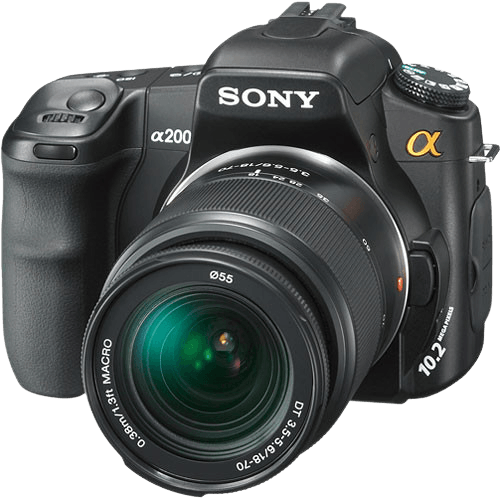Sony Alpha 200 Specs and Scores

The Sony Alpha 200 scores 40/100 in our evaluation. This DSLR camera was announced on January 7th, 2008, and released the same year with a launch price of $611. Measuring 131 x 99 x 71mm and weighing 572g (1.26lbs), the Alpha 200 is a relatively compact and lightweight option for a DSLR.
Considering its age and specifications, the Sony Alpha 200 struggles to compete in today’s market. However, it remains an affordable choice for those seeking a basic DSLR experience.
Sony Alpha 200 Overview and Optics
The optics of the Sony Alpha 200 receive a score of 49/100. This camera has 10.2 megapixels, a shooting speed of 3 frames per second, and a CCD sensor. The Bionz processor contributes to its performance, while the DXOMARK score for the sensor is 63. With an APS-C sensor size and a Sony Alpha DT lens mount, this camera also features image stabilization and a 3:2 aspect ratio.
In today’s market, the Sony Alpha 200’s optics specifications may not be considered top-of-the-line. Many current cameras offer higher megapixels, faster shooting speeds, and more advanced sensor types. However, the image stabilization and APS-C sensor size still hold value for some photographers.
The Sony Alpha 200 might not be the best choice for those seeking the latest and most advanced optics technology. Its score of 49/100 reflects the fact that it may not compete with newer models in terms of optical performance. However, it could still be suitable for photographers who prioritize image stabilization and the APS-C sensor size.
Sony Alpha 200 Video Performance
The Sony Alpha 200 lacks video capabilities. This camera only supports photography functions.
Sony Alpha 200 Features and Benefits
The Sony Alpha 200 features a score of 21 out of 100. This score reflects its lack of modern features compared to contemporary cameras. The screen size measures 2.7 inches with a resolution of 230,000 dots. While it does not have a touchscreen, it does include a flip screen for versatile shooting angles. However, it lacks GPS, WIFI, and Bluetooth capabilities, which are common in today’s market.
This camera’s specifications show it is not up-to-date with the current market standards, where most cameras include touchscreens and connectivity options for easy sharing and control. Despite its flip screen, the Sony Alpha 200 falls short in providing the desired features for photographers and videographers in this digital age.
The Sony Alpha 200’s low score and outdated specifications make it a less desirable option for those seeking a camera with modern features. Its limitations hinder its ability to compete with newer models that offer advanced technology and seamless connectivity.
Sony Alpha 200 Storage and Battery
The storage and battery section of the Sony Alpha 200 receives a score of 35 out of 100. The camera has a single memory card slot, accepting Compact Flash cards. In comparison to modern cameras that often support multiple card slots and various card types, the Alpha 200 falls short.
The battery life of the Sony Alpha 200 is 750 shots per charge, powered by an NP-FM500H battery. This number is average when compared to other cameras in the market. However, the Alpha 200 lacks USB charging capability, which is a common feature in today’s cameras for added convenience.
Taking these specifications into account, the Sony Alpha 200’s storage and battery performance does not stand out in the current market. Despite its average battery life, the camera’s limited storage options and lack of USB charging make it less appealing to potential buyers.
